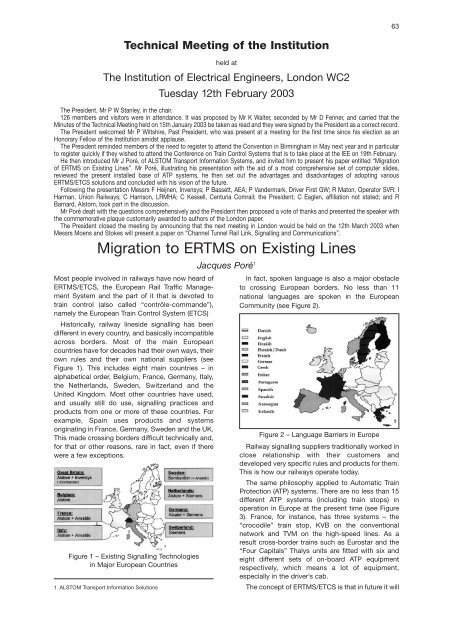Proceedings 2002/2003 - IRSE
Proceedings 2002/2003 - IRSE
Proceedings 2002/2003 - IRSE
You also want an ePaper? Increase the reach of your titles
YUMPU automatically turns print PDFs into web optimized ePapers that Google loves.
63<br />
Migration to ERTMS on Existing Lines<br />
Most people involved in railways have now heard of<br />
ERTMS/ETCS, the European Rail Traffic Management<br />
System and the part of it that is devoted to<br />
train control (also called “contrôle-commande”),<br />
namely the European Train Control System (ETCS)<br />
Historically, railway lineside signalling has been<br />
different in every country, and basically incompatible<br />
across borders. Most of the main European<br />
countries have for decades had their own ways, their<br />
own rules and their own national suppliers (see<br />
Figure 1). This includes eight main countries – in<br />
alphabetical order, Belgium, France, Germany, Italy,<br />
the Netherlands, Sweden, Switzerland and the<br />
United Kingdom. Most other countries have used,<br />
and usually still do use, signalling practices and<br />
products from one or more of these countries. For<br />
example, Spain uses products and systems<br />
originating in France, Germany, Sweden and the UK.<br />
This made crossing borders difficult technically and,<br />
for that or other reasons, rare in fact, even if there<br />
were a few exceptions.<br />
1 ALSTOM Transport Information Solutions<br />
Technical Meeting of the Institution<br />
held at<br />
The Institution of Electrical Engineers, London WC2<br />
Tuesday 12th February <strong>2003</strong><br />
The President, Mr P W Stanley, in the chair.<br />
126 members and visitors were in attendance. It was proposed by Mr K Walter, seconded by Mr D Fenner, and carried that the<br />
Minutes of the Technical Meeting held on 15th January <strong>2003</strong> be taken as read and they were signed by the President as a correct record.<br />
The President welcomed Mr P Wiltshire, Past President, who was present at a meeting for the first time since his election as an<br />
Honorary Fellow of the Institution amidst applause.<br />
The President reminded members of the need to register to attend the Convention in Birmingham in May next year and in particular<br />
to register quickly if they wished to attend the Conference on Train Control Systems that is to take place at the IEE on 19th February.<br />
He then introduced Mr J Poré, of ALSTOM Transport Information Systems, and invited him to present his paper entitled “Migration<br />
of ERTMS on Existing Lines”. Mr Poré, illustrating his presentation with the aid of a most comprehensive set of computer slides,<br />
reviewed the present installed base of ATP systems, he then set out the advantages and disadvantages of adopting various<br />
ERTMS/ETCS solutions and concluded with his vision of the future.<br />
Following the presentation Messrs F Heijnen, Invensys; P Bassett, AEA; P Vandermark, Driver First GW; R Maton, Operator SVR: I<br />
Harman, Union Railways; C Harrison, LRMHA; C Kessell, Centuria Comrail; the President; C Eaglen, affiliation not stated; and R<br />
Barnard, Alstom, took part in the discussion.<br />
Mr Poré dealt with the questions comprehensively and the President then proposed a vote of thanks and presented the speaker with<br />
the commemorative plaque customarily awarded to authors of the London paper.<br />
The President closed the meeting by announcing that the next meeting in London would be held on the 12th March <strong>2003</strong> when<br />
Messrs Moens and Stokes will present a paper on “Channel Tunnel Rail Link, Signalling and Communications”.<br />
Figure 1 – Existing Signalling Technologies<br />
in Major European Countries<br />
Jacques Poré 1<br />
In fact, spoken language is also a major obstacle<br />
to crossing European borders. No less than 11<br />
national languages are spoken in the European<br />
Community (see Figure 2).<br />
Figure 2 – Language Barriers in Europe<br />
Railway signalling suppliers traditionally worked in<br />
close relationship with their customers and<br />
developed very specific rules and products for them.<br />
This is how our railways operate today.<br />
The same philosophy applied to Automatic Train<br />
Protection (ATP) systems. There are no less than 15<br />
different ATP systems (including train stops) in<br />
operation in Europe at the present time (see Figure<br />
3). France, for instance, has three systems – the<br />
“crocodile” train stop, KVB on the conventional<br />
network and TVM on the high-speed lines. As a<br />
result cross-border trains such as Eurostar and the<br />
“Four Capitals” Thalys units are fitted with six and<br />
eight different sets of on-board ATP equipment<br />
respectively, which means a lot of equipment,<br />
especially in the driver’s cab.<br />
The concept of ERTMS/ETCS is that in future it will

















